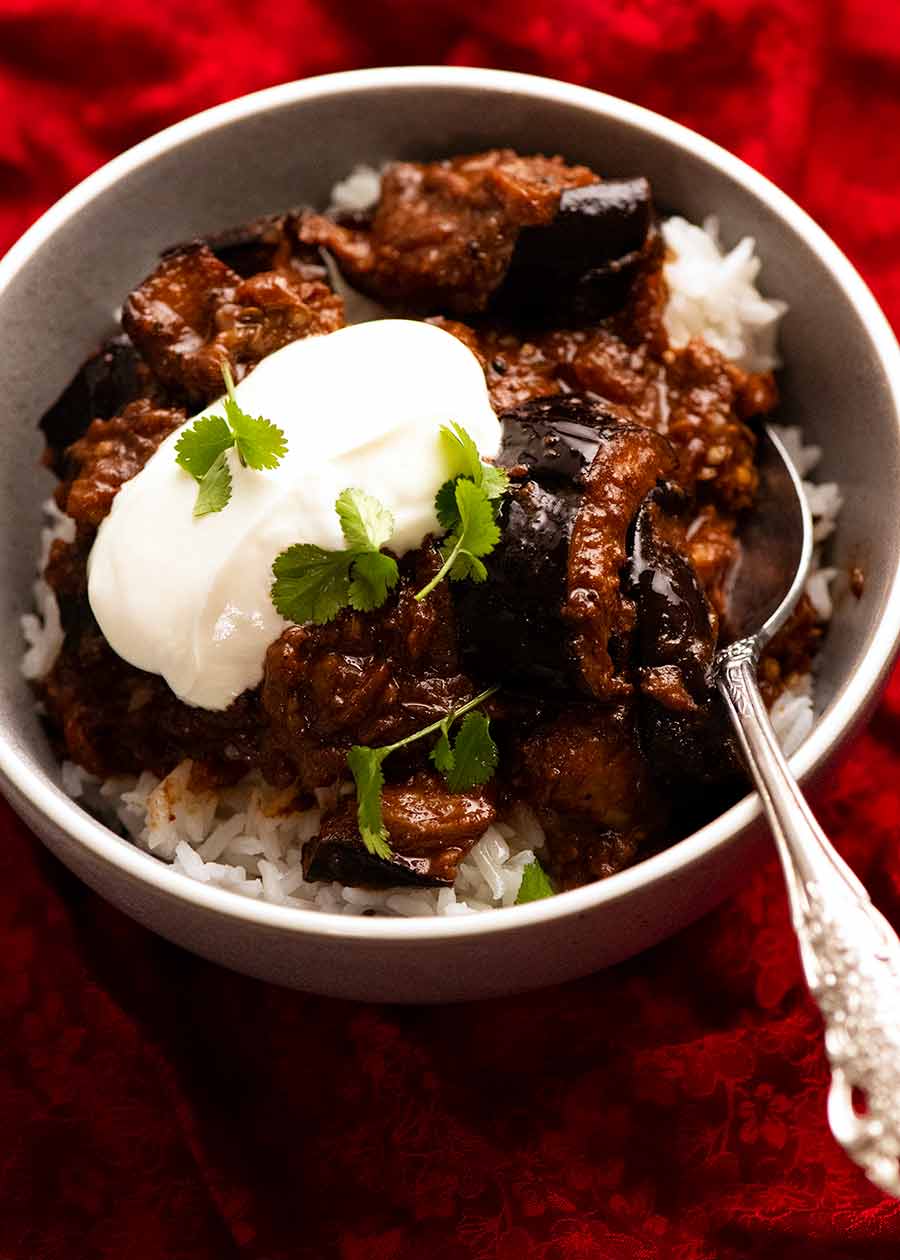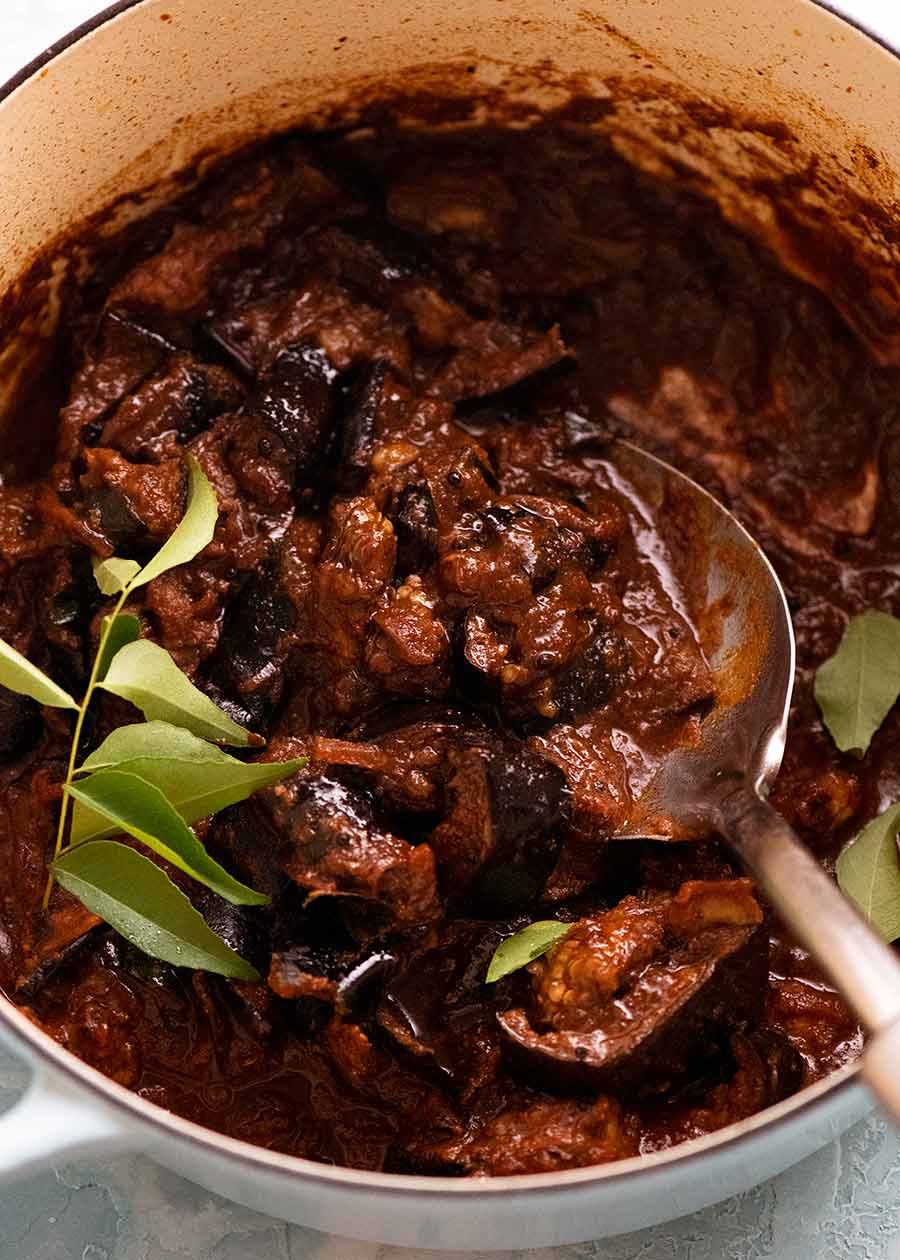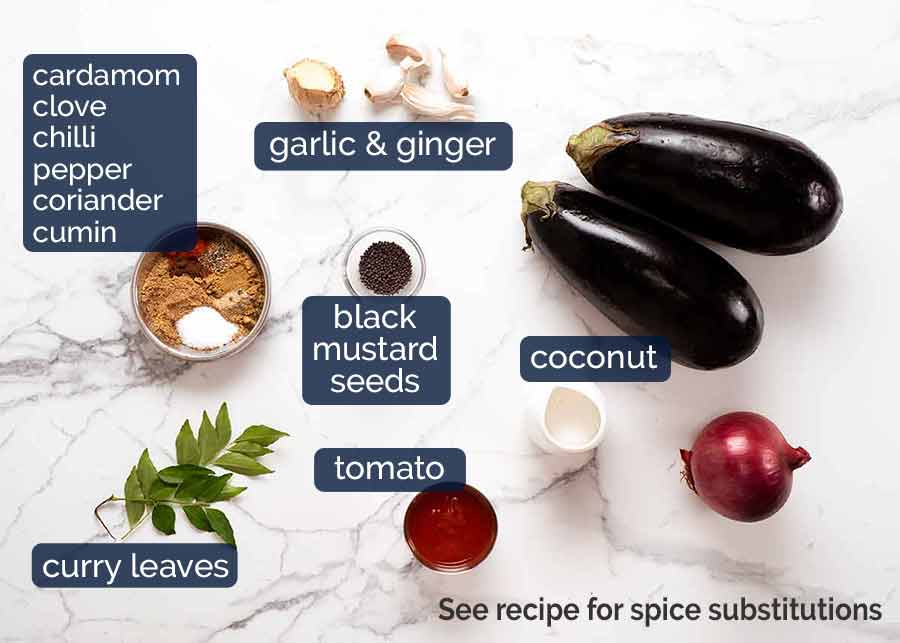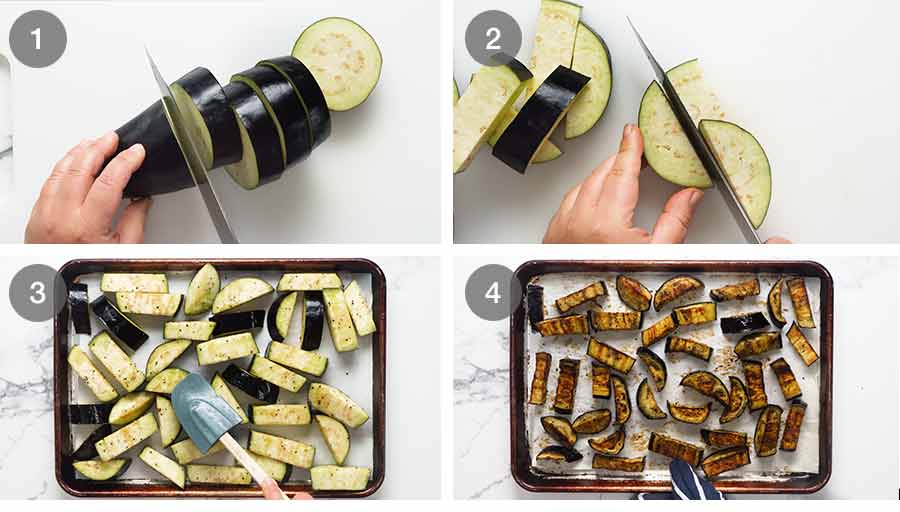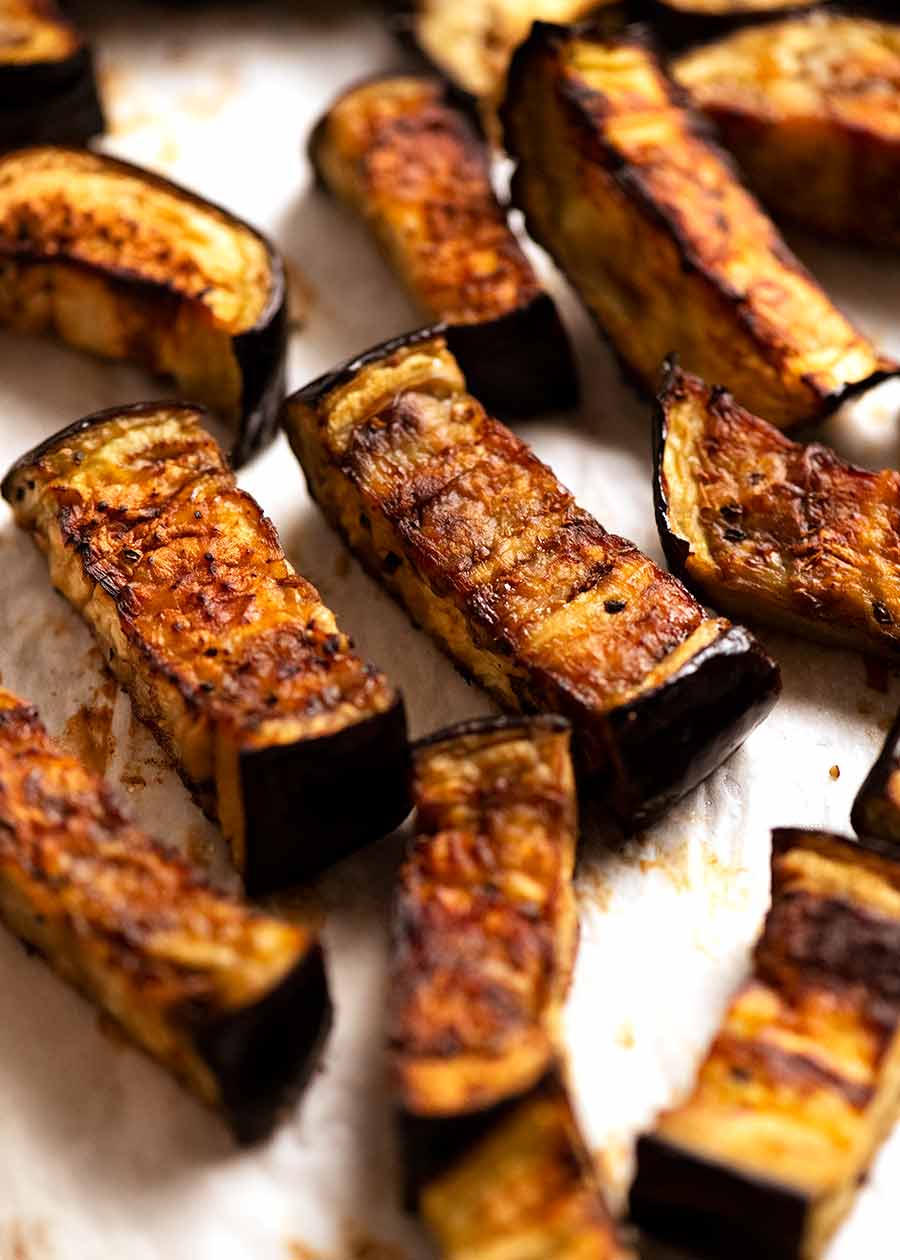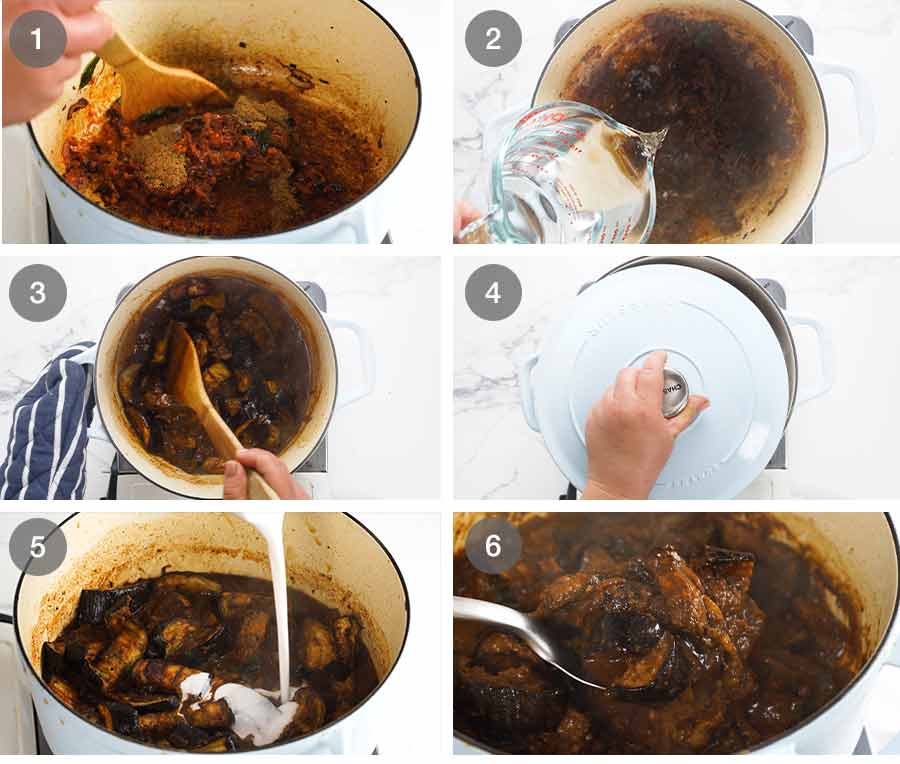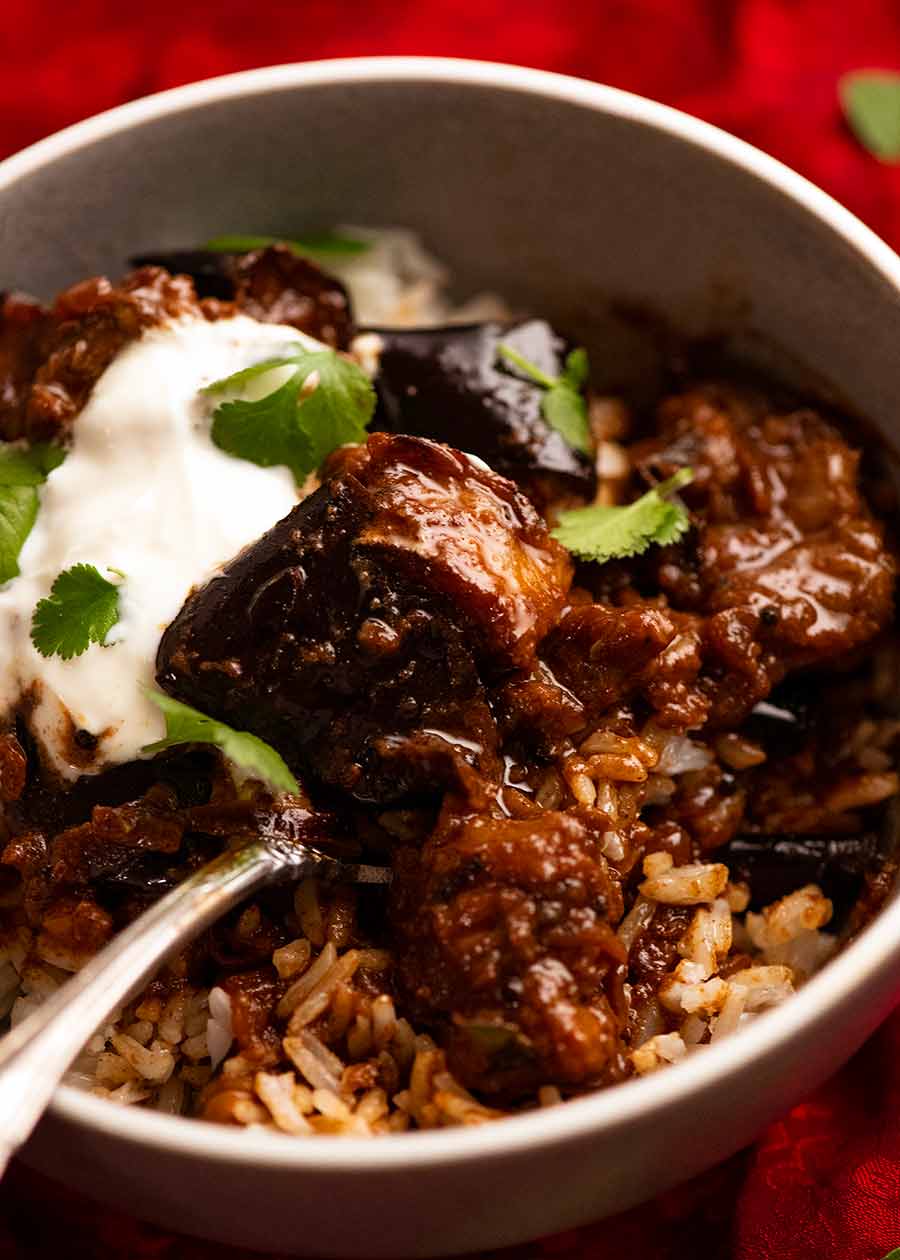Low cal at 250 calories and incidentally vegan. Yay vegans!
Eggplant Curry
This is a curry inspired by the famous Sri Lankan eggplant curry we love at New Shakthi Sri Lankan in Homebush (Sydney, Australia). It’s one of those “hole in the wall” places where the servers get grumpy if you dare to take the time to mull over which 3 curries you want in your lunch pack. “Hurry, hurry, people are waiting!” they say, gesturing at the queue forming behind you. And, flustered, I quickly jab my finger at a bunch of curries – because really, it doesn’t matter what you choose because everything there is good (and cheap). Their eggplant curry (Brinjal curry) is particularly famous – it has an intensely deep, smoky and sweet taste we suspect comes from deep frying the eggplant to get massive caramelisation and rich, oily goodness. This recipe is a more achievable and healthier home version, and because we can’t replicate the same Sri Lankan curry flavour without deep frying, we’ve had to head to a more general South Indian style. But the results are no less tasty! And much less oil!
What goes in eggplant curry
Here’s what goes in the Eggplant Curry. North Indian cuisine is historically influenced by the Arabs and Middle East, so tends to use more meat and dairy, with foods based on yogurt, ghee, and nuts – like Butter Chicken, Tikka Masala and Rogan Josh. Wheat is the staple crop, so you find flatbreads such as chapaati, paratha and naan are the more traditional meal accompaniments. The tandoor also originates from the north, hence dishes like Tandoori Chicken come from the north. South Indian food tends to be less meat-oriented, with vegetarian or seafood dishes made without dairy most common — such as this Eggplant Curry. Tropical produce naturally features heavily – coconut, tamarind, curry leaves, local vegetables distinct to the region — and the food can also be spicier. Rice and legumes are also the staples in the south, and from this part of the country hail legendary Indian dishes like dosa, vada and idli.
Don’t fret if you can’t get all the spices – I have solutions for you! See the recipe card notes. The two ingredients in this eggplant curry that makes it stand out as a truly authentic South Indian Curry are black mustard seeds and curry leaves.
Eggplant – small to medium eggplants are best so every piece has a bit of skin which helps them hold together when simmering in the sauce, rather than turning into a big pot of eggplant puree. Asian eggplants (the thin ones) will also work here; Black mustard seeds – they look like poppyseeds but have a slight wasabi-like bite to them. And they smell Indian, not Japanese! 😂 Not spicy, more a fresh zing. It’s about $1.50 in small packs at Indian grocery stores – I go to Indian Emporium in Dee Why on the Northern Beaches, Sydney. Also sold in the Indian food section at some Woolworths (Australia) $1.70, and also sold online – small, light pack so postage should be minimal! Also used in Dal and in this Vegetable Samosa Pie which is to-die for! Curry leaves – it smells like curry powder, but in fresh curry leaf form! (Though just so you know, curry powder isn’t derived from curry leaves 🙂 ) Curry leaves add incredible curry perfume into anything it’s used in. Fairly accessible nowadays for Sydney-siders, sold at Harris Farms, most Coles and Woolworths. I intend to find a plant! They keep for ages in the fridge – as in several weeks – or can be frozen. This too is used in Dal and the Vegetable Samosa Pie. Throw in 10 or so when cooking Curried Rice, or into this Indian Chickpea Curry or Vegetable Curry – it will really take it to a new level! Substitute: dried curry leaves (not quite the same, but it’s the best sub) or Garam Masala powder; The other spices – nothing out of the ordinary here, everything you find at local grocery stores; Coconut – coconut milk or cream is fine here. Only 3 tablespoons – it doesn’t make it taste of coconut, but it’s remarkable what a difference it makes to add a touch of luxury to the mouthfeel of this curry. Leftover coconut milk: Freeze the rest in ice cube trays and use in recipes that call for a splash of coconut. Otherwise, do a recipe search for “coconut milk” and select “Using this ingredient” and it will bring up a list of recipes that have coconut milk in the ingredients. Most recipes won’t suffer if you are short just 3 tbsp. Partial can uses: Gado Gado peanut sauce, scaled down batch of Thai Satay Peanut sauce. Tomato – anything is fine here, pulp or passata (base recipe), or canned crushed tomato (crush it more by hand to make it more fine) or even a dollop of tomato paste; Garlic and ginger – as with most Indian curries, a good wack is essential for a good curry experience!
How to make it – Roasted Eggplant for curry
Here’s how to roast the eggplant – cut into thick batons (they shrink a lot), then roasted at a high temperature with just 2 tablespoons of oil so the outside is nicely caramelised, the inside is soft and juicy, and it holds its form rather than collapsing into mush. Simply the best way to cook eggplant in the oven!
Notice how the eggplant pieces are beautifully browned on the outside and still holding their form, rather than being a soggy pile of mush (which is what happens if you roast at a lower temp). Just holding in the juicy insides!!
How to make Eggplant Curry
And here’s how the curry is made:
Fry off the mustard seeds and curry leaves – your house is going to smell insane! Cook off the ginger and garlic (your house will smell even more incredible!); Add the spices (your neighbours will catch a waft and start salivating); Then tomato and water, mix it up into a very intensely flavoured curry sauce; Add eggplant and simmer so it absorbs the flavour (neighbours will come knocking at this point); Then lastly, stir in the coconut milk (neighbours will be camped out on your door step, refusing to leave without a taste).
What it tastes like
This is not one for the faint hearted – it’s not mild and creamy like Butter Chicken. It’s a very intense authentic Indian curry flavour, as opposed to a generic flavour like those recipes you see made with a load of just “curry powder” and maybe some Garam Masala. The dominant flavour here are the curry spices – you can’t taste the tomato (for thickening the sauce) nor the coconut milk (for slight richness to mouthfeel). Also, another specific characteristic with this curry is that it’s not saucy. It’s one big pot of juicy (I’m going to say it!) MUSH. You don’t need a separate sauce!
Healthy! 250 calories per serve.
Indian food actually uses a LOT of oil in cooking. You would fall off your chair if you knew how much your friendly local Indian restaurant is using for his curries! Yes there’s still 5 tablespoons of oil in this, but it’s a vegetable curry so lacks all the additional fat that the meat in a meat curry would drop and so has to compensate to be tasty. But it’s not so unhealthy – in fact, it clocks in at just 250 calories per serving! Though if I had my way it would be 1/2 cup of oil ….😂 – Nagi x PS. Pictured here with basmati rice and dollop of yogurt. Naan or this simpler flatbread for stuffing wouldn’t go astray as alternatives. For a fresh side, try this South Indian-style Cabbage & Carrot Salad with Coconut, this Minted Yogurt Tomato Salad, this fresh creamy Cucumber Salad or even plain roasted Broccolini (skip the Tahini sauce in the recipe). More Veg and Salad Sides here. And if you’re going low carb, use Cauliflower Rice instead (the sauce is so strong, you won’t care).
Watch how to make it
More Eggplant recipes
For fellow carnivores who love how “meaty” eggplant is!
More Curry recipes – for fellow curry monsters!
Life of Dozer
There’s a Dozer under there somewhere… This is how he spent half of Sunday after a big beach play with his mates!
